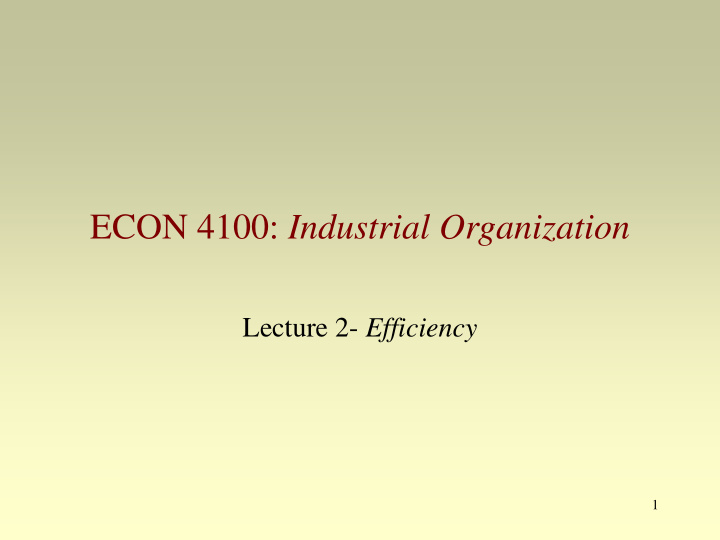



ECON 4100: Industrial Organization Lecture 2- Efficiency 1
Overview • Efficiency and markets • Pareto Efficiency • Consumer Surplus and Producer Surplus revisited • A non-surplus approach to efficiency 2
Efficiency and Surplus • Can we reallocate resources to make some individuals better off without making others worse off? • We need a measure of well-being – consumer surplus: difference between the maximum amount a consumer is willing to pay for a unit of a good and the amount actually paid for that unit – aggregate consumer surplus is the sum over all units consumed and all consumers – producer surplus: difference between the amount a producer receives from the sale of a unit and the amount that unit costs to produce – aggregate producer surplus is the sum over all units produced and all producers – total surplus = consumer surplus + producer surplus 3
Efficiency and surplus: illustration $/unit The demand curve measures the willingness to pay for each unit Competitive Consumer surplus is the area Supply between the demand curve and the equilibrium price Consumer Equilibrium occurs surplus The supply curve measures the where supply equals P C marginal cost of each unit demand: price P C Producer Producer surplus is the area quantity Q C surplus between the supply curve and the equilibrium price Demand Aggregate surplus is the sum of consumer surplus and producer surplus Q C Quantity The competitive equilibrium is efficient 4
Illustration (cont.) $/unit Assume that a greater quantity Q G is traded The net effect is a Competitive Price falls to P G reduction in total Supply surplus Producer surplus is now a positive part and a negative part P C Consumer surplus increases P G Part of this is a transfer from producers Demand Part offsets the negative producer surplus Q C Q G Quantity 5
Deadweight loss of Monopoly $/unit Assume that the industry is monopolized Competitive The monopolist sets MR = MC to Supply give output Q M This is the deadweight The market clearing price is P M loss of monopoly P M Consumer surplus is given by this area P C And producer surplus is given by this area The monopolist produces less Demand surplus than the competitive industry. There are mutually beneficial trades that do not take Q M Q C MR Quantity place: between Q M and Q C 6
Deadweight loss of Monopoly (cont.) • Why can the monopolist not appropriate the deadweight loss? – Increasing output requires a reduction in price – this assumes that the same price is charged to everyone. • The monopolist creates surplus – some goes to consumers – some appears as profit • The monopolist bases her decisions purely on the surplus she gets, not on consumer surplus • The monopolist undersupplies relative to the competitive outcome (it is like an externality or a public good kind of problem) • The primary problem: the monopolist is large relative to the market 7
A Non-Surplus Approach • Take a simple example • Monopolist owns two units of a valuable good • There are 50,000 potential buyers • Reservation prices: Number of Buyers Reservation Price First 200 $50,000 Next 40,000 $30,000 Last 9,800 $10,000 Both units will be sold at $50,000; no deadweight loss Why not? Monopolist is small relative to the market. 8
Example (cont.) • Monopolist has 200 units • Reservation prices: Number of Buyers Reservation Price First 100 $50,000 Next 40,000 $15,000 Last 9,900 $10,000 Now there is a loss of efficiency and so deadweight loss no matter what the monopolist does. 9
Moreover: • Additionally, there may be a lot of rent-seeking, so more resources are wasted!!! • And x-inefficiency because the monopolist becomes a lazy monopolist 10
However: • However, the prospects of reaping monopoly profits may encourage firms to be more creative and innovative and develop better products • In a dynamic view of the economy, a monopoly might not be that bad • This is the idea defended by Peter Schumpeter (and Bill Gates of course ☺ ) • And it is the rationale behind patent policies 11
Next • Market structure and market power • Read Ch. 3 and revisit Ch. 1 12
Recommend
More recommend